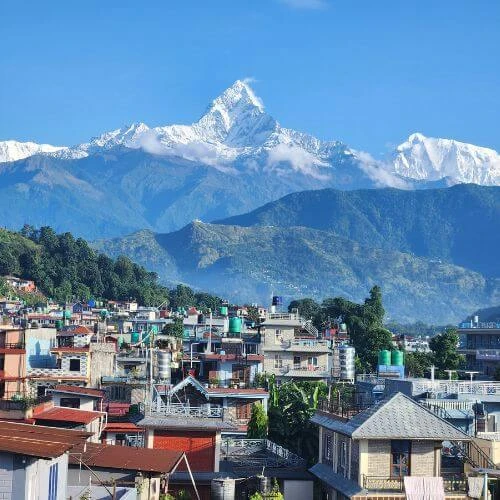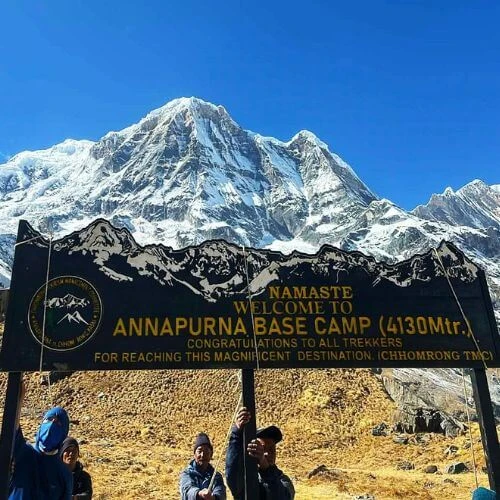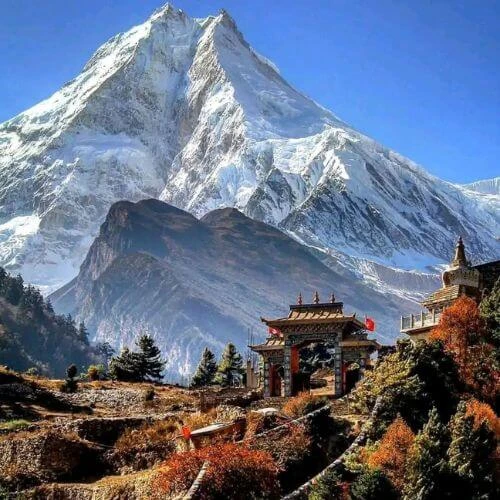Legend, Myths, and History of Holi
Holi, a major Hindu festival, is celebrated on the full moon day, known as "Fagu Purnima," with immense joy. It marks the arrival of spring and is denoted by vibrant colors, water play, music, and dance. The festival celebrates the victory of good over evil and promotes unity and happiness. There are various myths associated with Holi, one of them being the legend of Hiranyakashipu, an ancient demon king. Hiranyakashipu tried to kill his son Prahlada, who was a great devotee of lord Vishnu, with his sister Holika's assistance. However, the plan backfired, and Holika burned herself while Prahlada was protected. Afterward, Vishnu defeated Hiranyakashipu, showing that good triumphed over evil. In various areas of Nepal, people light big fires on the night before Holi to remember this event.
Another Holi myth is associated with Lord Krishna, a form of Vishnu, and his childhood love Radha. In Krishna's birthplace, the festival was celebrated as Rang Panchami in memory of their divine love. Krishna, born with a dark complexion, felt insecure about it, but his mother assured him that Radha would love him regardless of his skin color. Following her advice, Krishna asked Radha to color his face, symbolizing their inseparable bond. Thus, Holi is also seen as a celebration of love, represented by the multitude of colors and joys during the festivities. Holi in Basantapur is a fantastic celebration that attracts tourists with its lively and colorful atmosphere. The streets are filled with people from different places, all joining in the fun and creating a cheerful and diverse environment. You get to experience traditional rituals, energetic dancing, and the pure joy of the celebration. The cultural variety and richness during Holi in Basantapur make it a must-see event for anyone looking for a genuine and immersive cultural experience in Nepal.
In Terai, some also connect it with lord Ram's return and being showered with colors.

The significance of Holi
Holi, according to Hindu literature, represents the triumph of good over evil, particularly the victory of Lord Vishnu over Hiranyakashipu. The tradition of smearing each other with colors symbolizes the victory of good, fostering a spirit of love, playfulness, laughter, forgiveness, and the renewal of relationships. It's a day to forget grievances, mend broken bonds, and embrace the joyful essence of life.
Religious significance
Holi is a two-day celebration, usually falling in late February or early March. The name "Holi" comes from Holika, the sister of King Hiranyakashap. The king was proud of his powers and wanted everyone to worship him instead of the gods. Despite threats from his father, Prahladh, his son, refused to obey him. Holika convinced the king to sit in a bonfire with Prahlad on her lap, intending to harm the boy. However, Holika herself was harmed in the fire, while Prahladh, who was a devoted follower of Lord Vishnu, survived. Holi is celebrated to honor Prahladh's unwavering faith in the Lord.
The tradition of playing with colors during Holi is linked to the love story of Radha and Krishna. Lord Krishna, who had a dark complexion complained to his mother about the fair Gopis and Radha making fun of him. His mother suggested he could color them as he pleased.
Cultural Significance
Holi is a celebration of various legends that emphasize the triumph of good over evil, reinforcing the power of truth. The stories, including the one about Hiranyakashyap and Prahlad, highlight the rewards of unwavering devotion to God. These legends inspire people to adopt good conduct in their lives and believe in the importance of honesty, especially in a society where some resort to unethical practices. The ritual of lighting a bonfire during Holi also represents the victory of good over evil. This ritual symbolizes the burning of negativity, ego, and desires. The festival itself embodies bonding, friendship, unity, and peaceful coexistence.
In today's world, where many people engage in dishonest actions for small gains and mistreat those who are honest, Holi encourages individuals to hold onto the truth and fight against evil. The festival takes place when fields are in full bloom, anticipating a good harvest, providing a joyful reason for people to celebrate.
Biological significance
Holi itself doesn't have direct biological significance, as it is primarily a cultural and social celebration. However, it does have some indirect biological significance in terms of impact on human psychology and well-being, contributing to a sense of community, connection, and positivity. Research indicates that engaging in social and cultural activities, like Holi celebrations, can reduce feelings of loneliness, depression, and anxiety. The act of playing with colors and water during Holi serves as a form of stress relief and physical exercise, positively impacting overall health.
Holika Dahan's traditional bonfire isn't just symbolic; it has a practical purpose. It's believed to disinfect the environment by raising temperatures, possibly reducing the spread of germs and viruses that are more active during the shift from winter to spring. Some ingredients in traditional Holi colors, like turmeric and sandalwood, have antiseptic properties that can protect the skin.
The Hindu festival Holi, is celebrated in late February or early March, a time when people might feel lazy or tired due to the changing weather. During Holi, throwing colors is believed to give the body a boost, making it feel more energetic and beautiful.
Social Significance
Holi has many social impacts that can vary based on where and how it's celebrated. Some significance includes strengthening connections by bringing people together to celebrate, play, and socialize. The festival is a chance to mend relationships, build new connections, and break social barriers. Holi's inclusive nature welcomes everyone, briefly putting aside social differences like caste, class, and gender. This allows people from diverse backgrounds to interact freely and equally during the festival. Celebrated in Nepal and various parts of South Asia, Holi promotes appreciation for diverse cultures and traditions. People exchange gifts and treats during Holi, fostering generosity and kindness.
Traditions and Rituals of Holi
Holi, a vibrant festival celebrated in Nepal, India, and around the world, is all about spreading joy and colors. Starting with a lively bonfire the night before, where people sing and dance, the next morning turns into a lively carnival of colors. Everyone, regardless of age or background, joyfully plays and chases each other with colored powders and water. It's a day of forgetting grievances, forgiving, and repairing relationships. Holi marks the end of winter, making it a special time for people to come together, play, and celebrate life.

Holika Dahan (Bonfire)
Holika Dahan, the bonfire in Holi, is a significant Hindu celebration that happens before Holi. It is a special time when communities come together to mark the victory of good over evil and welcome the arrival of spring. People gather in the evening to light bonfires made of twigs, wood, and cow dung. These bonfires, shaped like the demoness Holika, are lit with prayers and chants. As the fire burns, everyone offers grains, coconuts, and sweets as symbolic gestures. The burning doll of Holika on the bonfire represents getting rid of bad feelings, mistakes, and negativity. It's believed that the crackling flames and rising smoke purify the surroundings, bringing in positive and auspicious beginnings for everyone.
Playing with colours
Holi is an incredibly fun and colorful celebration that marks the arrival of spring in Nepal and is enjoyed by people worldwide. The colors used during Holi have a rich history, originally from natural ingredients like turmeric and beetroot. When it's time to play, people gather armed with colored powders and water-filled balloons or guns. The streets come alive with laughter and music as everyone joins in the playful throwing and splashing of colors, turning each person into a living rainbow. Beyond the joy and colors, Holi holds a deeper significance. It brings people together, breaking down social barriers and promoting forgiveness and unity.
Pooja and Prayers
During Holi, many families take part in a special Holi Puja, with a mix of spiritual rituals. Prayers are offered to Lord Vishnu, especially in his Narasimha form, and people make offerings like coconut, flowers, grains, and sweets while circling the bonfire. On the day of Holi, families conduct a household puja, often in the morning. This typically involves offering prayers to Radha and Krishna, symbolizing love and joy, with decorated idols and offerings of flowers, fruits, sweets, and milk. Chanting mantras and seeking blessings for family and community are part of the ritual, and in some regions, puja is also dedicated to other deities. These rituals hold significance as they aim to attract blessings for health, prosperity, and the removal of negativity.
Dancing and singing
Holi in Nepal is more than just colors; it's a lively celebration filled with music and dance. Traditional instruments like Sarangi, Madal, and bansuri create rhythmic beats, while dhol drums and harmoniums add to the festive tunes. In the Terai region, there's a special touch with indigenous instruments like Jhurma and Dholki. The celebration gets even more exciting with dances like "Jhijhiya" and "Jhumer" performed by Tharu communities, known for their energetic moves and vibrant costumes.
Bhang, sweets, and snacks
During Holi in Nepal, people enjoy special elements like Bhang, sweets, and snacks. While Bhang, a cannabis-infused drink, is less commonly consumed compared to some parts of India, people may go for milder forms like Bhang chutney or sweets with a hint of Bhang essence. It's crucial to be responsible about consumption and be aware of local laws. Sweets are central to the festivities, representing sweetness and new beginnings. Popular choices include Gulab Jamun, Rasgulla, Barfi, Sel Roti, and Puran Poli, which are shared to strengthen bonds and add joy to the celebrations. Balancing out the sweetness, savory snacks like samosas, pakoras, and aloo tikki, are enjoyed with pickles. So, Holi in Nepal is not just about colors—it's a flavorful celebration with a variety of treats!

Holi for Beginners: Essential Tips for Playing Holi
Before immersing yourself in the lively and colorful celebrations of Holi, consider a few important things to ensure a safe and enjoyable experience. This festival is renowned for its energetic and carefree atmosphere, and being mindful of specific factors can enhance the overall experience for everyone involved.
Skin and Hair Protection
Before playing Holi, apply plenty of oil or moisturizer/Vaseline to your skin and hair. This layer helps in washing off the colors easily later and protects your skin from potential irritation. Additionally, if you're blonde, take some precautions to avoid color stains.
Keep your eyes safe
Ensuring a safe and happy Holi celebration means caring for your eyes. Start by wearing sunglasses or goggles instead of contact lenses for the best protection, using polycarbonate lenses if possible. Go for natural colors made from flowers and leaves to avoid harsh chemicals. Before the fun begins, apply lubricating eye drops to keep your eyes moist. During the festivities, be cautious of direct color hits on your face, especially near your eyes. If color gets in your eyes, resist rubbing and gently rinse them with clean water.
Use safe colors
When celebrating Holi, it's important to use safe colors for a joyful experience. Choose natural colors made from flower petals, herbs, or other organic ingredients, as they are gentle on your skin and eyes. Look for labels like "herbal," "organic," or "natural" when buying colors. You can even make your own at home using ingredients like turmeric or beetroot. Avoid synthetic colors with harsh chemicals that irritate your skin and eyes, and go for certified safe colors. For instance, red can be from red sandalwood or beetroot powder, yellow from turmeric or marigold flower powder, green from spinach or mint leaves powder, blue from indigo or hibiscus flower powder, and pink from rose petal powder or beetroot mixed with yogurt.
Don’t eat or drink unknown items
It's really important to be careful about the food and drinks you have during Holi, especially when it comes to stuff like bhang. Bhang is made from cannabis, and if you have it without knowing or being careful, it can make you feel weird and even be risky. Some people might have a bad reaction, feeling anxious or uncomfortable. To stay safe, never take food or drinks from strangers, stick to places you know are clean and safe, and be honest about what's in the stuff you're sharing. Everyone's got the right to choose what they eat or drink, so respect their decisions. If you do decide to try bhang, be responsible, do it in a safe place, and don't overdo it.
Wear white
Wearing white on Holi is a cool tradition for a few reasons. First, white represents a fresh start and purity, matching the Holi vibe of forgiveness and renewal. Plus, it makes the colorful Holi powders pop, creating a cool look. White also helps you stay cooler in the sunny Holi weather. Just remember, your white outfit might get stained.
Don’t leave a mess
It's super important to keep things clean and tidy during Holi for a better time for everyone. Before the fun starts, bring reusable bags to avoid using throwaway plastic. Pick natural and biodegradable colors that are good for the environment. Try using fewer water balloons to cut down on mess and water use. While playing, be careful where you throw colors. After the celebrations, pitch in with any cleanup efforts and be smart about washing your colored clothes. Spread the word to celebrate responsibly and keep Holi awesome and eco-friendly!

Conclusion
Holi is a lively and friendly festival celebrated with excitement in many places. It started long ago in Hindu traditions and has become a celebration of togetherness, joy, and the lively spirit of spring. People have fun throwing colorful powders, lighting bonfires, and sharing yummy treats, creating an exciting atmosphere that brings everyone closer.
Holi isn't just for certain areas—it's celebrated worldwide. This festival represents the victory of good over evil and highlights the importance of getting along and enjoying the company of others. Whether you're in Nepal or anywhere else globally, Holi is a special celebration that brings people from different backgrounds together, spreading happiness and a feeling of togetherness.
FAQs
When is Holi in Nepal in 2080?
- Fagu Purnima/Holi is set to occur on March 24 (Chaitra 11) in the Hilly region and on March 25 (Chaitra 12) in the Terai region this year in Nepal.
How is Holi celebrated?
- People celebrate Holi by playing with colored powders and water, engaging in music and dance, and enjoying festive foods. On the evening of Holi, bonfires are lit and referred to as Holika Dahan.
What is the scientific reason behind Holi?
- Holi has several scientific significance, including burning wood during the festival, which serves several important purposes. Firstly, bonfires made from leaves and wood collected from homes and streets clean up the environment by eliminating waste and dead plants, and purifying the surroundings before spring arrives. Secondly, burning wood is thought to release purifying smoke that cleanses the air from bacteria and insects, possibly preventing disease in spring. Further, research indicates that engaging in social and cultural activities, like Holi celebrations, can reduce feelings of loneliness, depression, and anxiety.

Are there any safety precautions during Holi?
- It's advisable to use natural and safe colors, as some synthetic ones may cause skin irritation. Additionally, staying hydrated and respecting others' boundaries while playing are important safety measures.
How long has Holi been celebrated?
- Holi has ancient roots dating back over 2,000 years. Its origins are traced to various Hindu mythologies and traditions, making it a time-honored festival.










